The Alphacool NexXxoS Cool Answer 360 DDC/XT Liquid Cooling Kit Review
by E. Fylladitakis on October 24, 2016 9:30 AM ESTThe Alphacool Repack Reservoir
The Alphacool Repack is a reservoir designed to fit into a 5.25” external drive bay. This kit includes the DDC version of the reservoir that is designed to be joined with a Laing DDC pump. Although this particular version cannot be used with any other kind of pump, Alphacool offers several versions of this reservoir, including a simple version with compression fittings only.
The Repack is made almost entirely out of clear acrylic. The acrylic is very thick and inflexible, giving the reservoir exceptional overall mechanical strength. Alphacool installs a black metallic plate at the front of the reservoir with their logo, mainly serving as a level meter, but it can be removed if the user wishes. A metallic support plate at the rear of the reservoir is used as a support for the pump.
Two round openings for the pump’s headers and two threaded openings for compression fittings can be seen at the rear of the Repack. Note that the reservoir has internal pathways that separate the incoming and outgoing flows. The left of the compression fittings leads directly to the output of the pump, while the right fitting is for the incoming flow that leads the liquid into the reservoir. Unfortunately, there is no decoupling method for the pump, as it gets attached directly onto the metallic support plate. This transfers all of the vibrations of the pump to the reservoir and, in extension, to the case. Depending on the materials and the quality of the case, this can increase the overall noise output of the system.
The Laing DDC-1T pump
The Laing DDC-1T pump is not of Alphacool’s design. Rather the pump is a product of Goulds Water Technology, a Xylem brand, a company that specializes on commercial and industrial pumps. So that the pump could be used inside a PC, Alphacool merely attached a Molex power connector and a 3-pin tachometer sensor.
Although it looks like a very simple plastic apparatus, the DDC-1T is actually one of the best low-voltage DC pumps currently available. It utilizes a hemispherical motor that does not require shaft bearings and/or seals, significantly improving reliability and minimizing noise. The DDC-1T is also very powerful for a 10W device of this size with, according to Alphacool, a maximum discharge head of 3.7 meters and a maximum flow of 420 l/h. Goulds Water Technology states 4.5 m head and 410 l/h respectively in their specifications sheet.
The only downside of the DDC-1T is the narrow voltage operating range. This particular model can only operate with a voltage of 8V to 13.8V (12V maximum for a typical PC) and has a starting voltage of at least 9V, severely limiting its speed control capabilities. This is why Alphacool offers it with a Molex power connector; although your motherboard’s header should not have an issue powering the 10W pump, the company does not expect users to try and speed control it, as it can easily stall and stop if the supplied voltage drops under 8V, or not even start under certain situations.
Alphacool HF Brass Compression Fittings
Although the selection of proper fittings may seem like a mundane task, there are at least a few things that serious water cooling users need to be aware of. The first is the material of the fitting, as certain metals can cause serious corrosion even when using highly anti-corrosive liquid mixtures, and the second is the coloring (if present), as colors will fade very rapidly on certain materials like copper and brass.
Things get a little more complicated with compression fittings. Unlike simple barbed fittings, the compression fittings are made for tubing with a specific internal and outer diameter (ID and OD respectively). They are more convenient as this allow the user to tighten them by hand and offer more room for aesthetic interventions, but their nature requires precise machining with minimal tolerances. A poor quality compression fitting can easily become the source of leaks.
Alphacool’s HF fittings are made of brass and specifically for 13/10 mm OD/ID tubing. They are painted back with a chromating method that binds the color to the brass, preventing fading. The locking rings have a textured design for better grip. At nearly 6€ per piece, these are rather expensive, but the quality assurance is probably worth the high cost in a system that a poor quality item can cause catastrophic failures.
Alphacool Coolmove 2 Fans
Alphacool also supplies three 120 mm fans with this kit. The fans have black glossy frames and semitransparent blue blades. The blades are not flat but have jagged edges and hemispherical engravings, giving it a golf ball appearance. Their cables are sleeved using typical nylon black sleeving.
The company has rebranded the fans, hiding the OEM from the public. According to their specifications, these fans has a maximum speed of 1300 RPM and Hydro-Dynamic Bearings. It seems strange that the company decided to include a nine-blade design in a kit with a radiator this thick; fans with fewer and wider blades would have better pressure and could achieve better performance, especially at lower RPM. Alphacool however states that the XT45 is optimized for low/medium speed fans, which explains their choice.


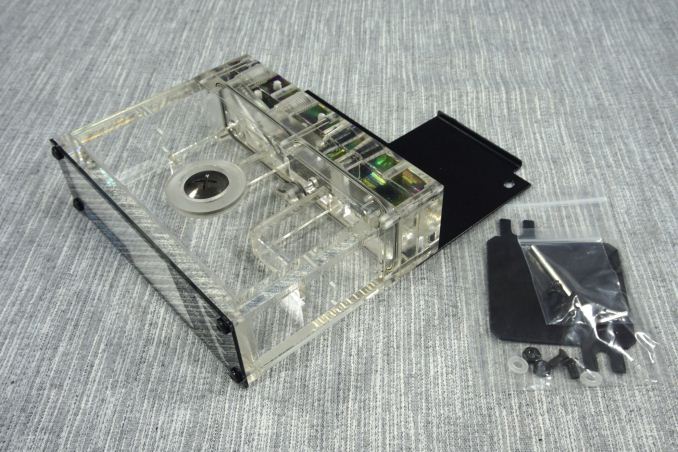


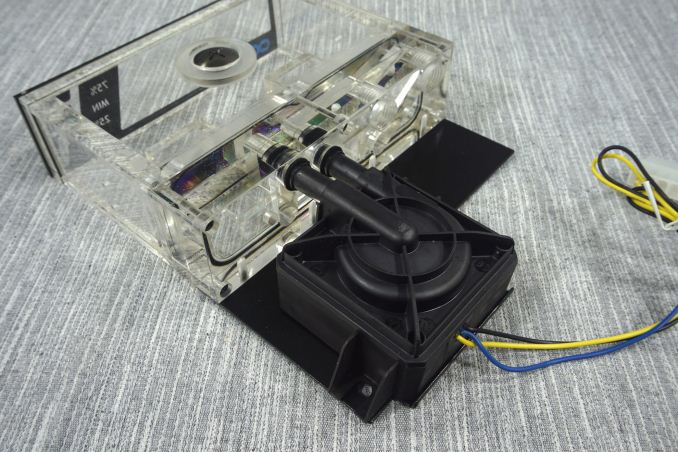

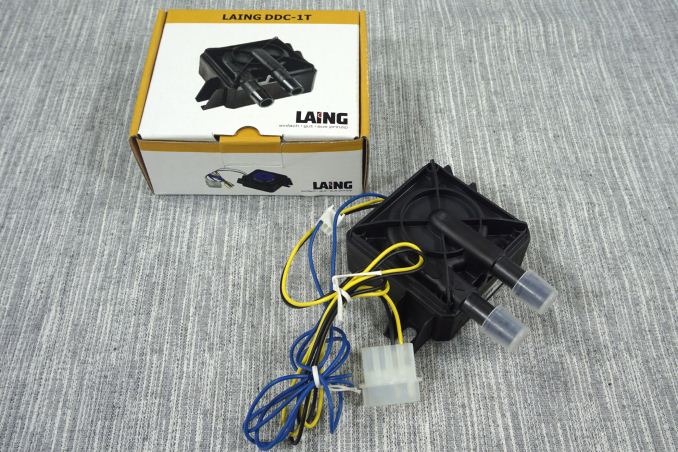
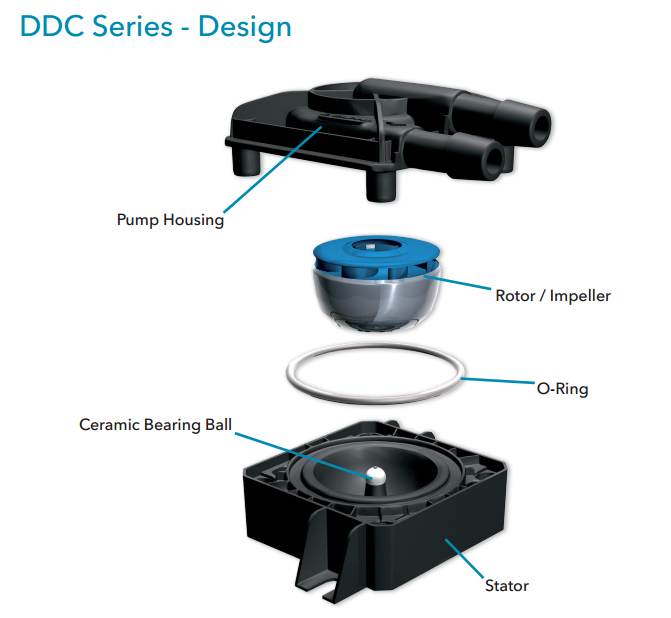
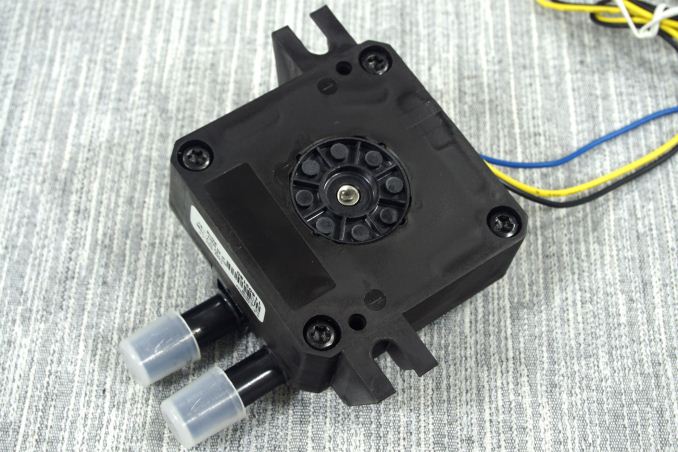
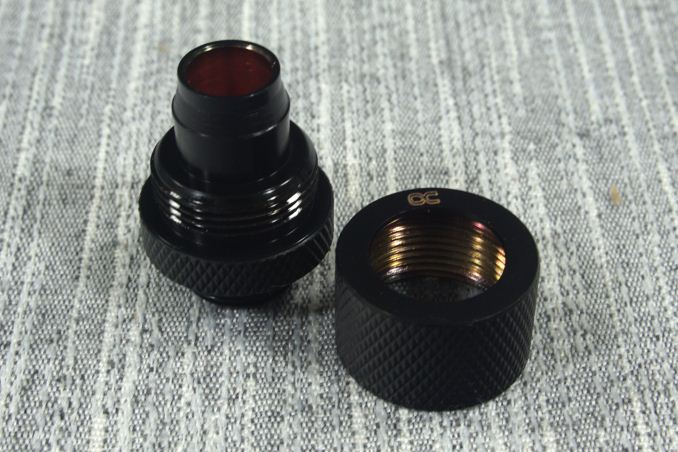
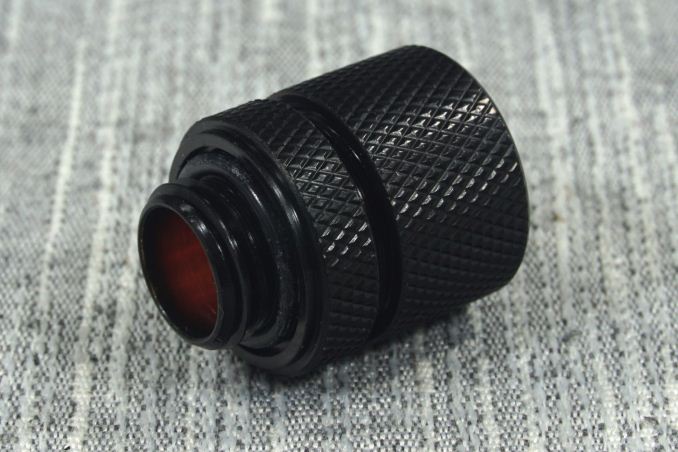
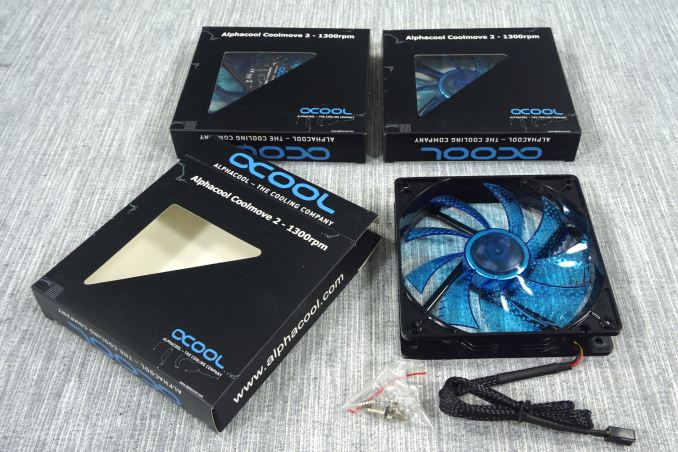
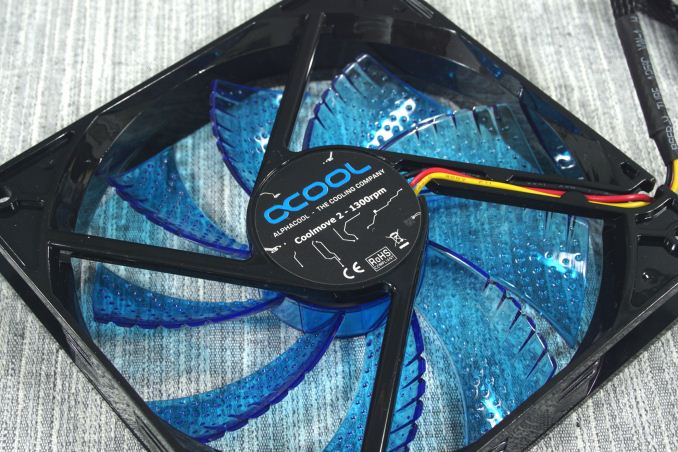








40 Comments
View All Comments
Death666Angel - Tuesday, October 25, 2016 - link
That works for people hard of hearing, those willing to put up with abysmall thermals and/or loud noise or those like you who have enough space and willingness to put the source of the noise in another part of their dwelling.BrokenCrayons - Tuesday, October 25, 2016 - link
That's a lot of exaggeration. Stock coolers are ear-splitting monsters that let the chip run at unsafe temperatures. There are literally billions of PCs that have been shipped with OEM coolers over the years and while a few designs have been fatally flawed (I'm looking at you ECS GREEN320 laptop with your whiny hair dryer blower on a 1GHz VIA C3 processor) the vast majority of them provide years of problem-free service by keeping the CPU within manufacturer specified temperature limits without causing undue end user stress due to poor acoustic design.Keep it in perspective. I'd happily agree that temperatures might be lower and the computer might be quieter with a bit of attention paid to cooling, but the way you're putting things seems overly dramatic.
HollyDOL - Monday, October 24, 2016 - link
I moved to custom loop to get rid of "angry vacuum cleaner" (back in 8800GT days). My pump is sitting in a foam inside the case and radiator is external, passive and quite big. In combination with noise dampening case and semi-passive PSU it's silent at city night (I guess in significantly quieter environment you could hear a bit but not really much).galta - Monday, October 24, 2016 - link
Liquid cooling is for people for want/need extreme performance, generating tons of heat in the process. Heatsinks that come out of the box cannot handle it.There is also the question of noise, for cooling an OCed system on air produces - generally - more noise than on liquid.
Those, however, do not seem to be circumstances that apply to you, so you better stay on air.
JoeyJoJo123 - Monday, October 24, 2016 - link
I'd clarify the "generally" part as follows:If they're using an AIO, chances are the combined pump + fan noise is actually noisier than a dual stack tower heatsink. (2x 120mm or 140mm fan + pump noise VS 2x 120mm or 140mm fans and no pump).
If they've built a custom open loop, then chances are that they've over-engineered the solution (as the few who go this route have the cash to spend and are willing to go all the way) and are using a thick radiator, a large reservoir, a large but quiet pump, and fans that don't ever need to spin up to address increased heat on intensive tasks, and at this point, they might actually have a quieter solution.
galta - Monday, October 24, 2016 - link
Lots of chances involved, it seems. In the end, what makes sense - generally - is to understand your problem and look for the best way to solve it.For some, air will do; for others, not.
Check Corsair's H110iGT review @ Guru3d: it is as quiet as the venerable Noctua NHD15, but 9C cooler when overclocking an i7 4790k. Oh, and it also significantly lighter than 1.32kg.
But then there is our friend BrokenCrayons, mixing bunnies with pancakes...
fanofanand - Tuesday, October 25, 2016 - link
I thought his points were valid and reasonable, far from mixing bunnies with pancakes.BrokenCrayons - Monday, October 24, 2016 - link
To steal a certain internet meme, "Overclocking in 2016 makes about as much sense as a bunny with a pancake on its head."Aerodrifting - Monday, October 24, 2016 - link
What's the point of running X99 i7 if you don't overclock? So you can be content with stock 3.0 speed?BrokenCrayons - Tuesday, October 25, 2016 - link
What's the poinnt of overclocking it? The home user's typical workloads don't benefit from overclocking and if they do, the increase in performance is marginal and not worth the effort. Sure there's showboating to friends and emotional self-gratification, but those aren't tangible rewards. If emotional satisfaction is what you gain from that sort of thing, then knock yourself out, but in my opinion, it's wasteful, childish, and silly.